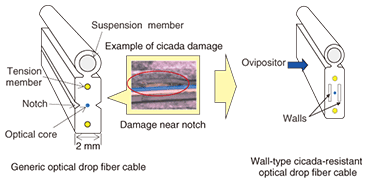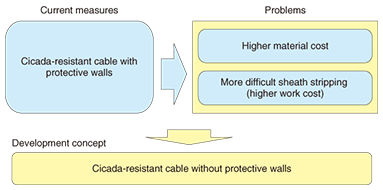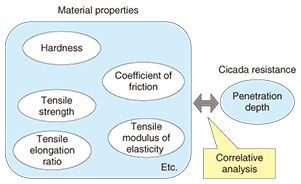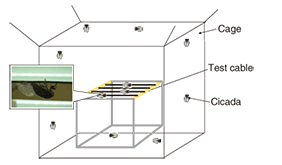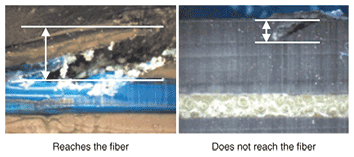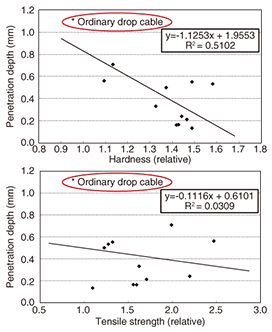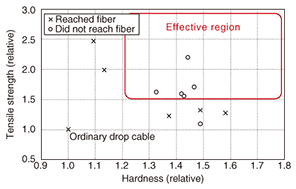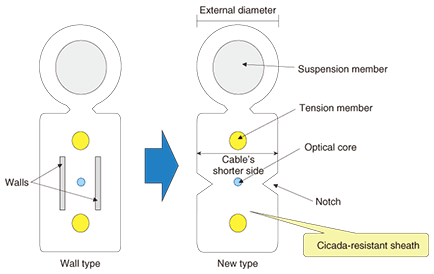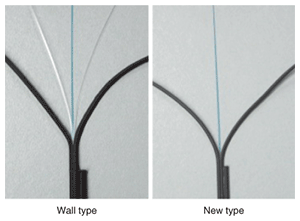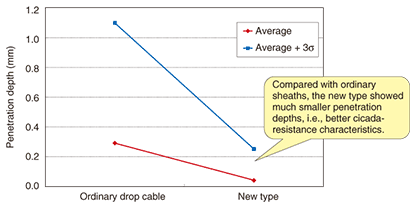 |
|||||||||||
|
|
|||||||||||
|
Regular Articles Vol. 9, No. 6, pp. 36–41, June 2011. https://doi.org/10.53829/ntr201106ra2 Lower-cost Cicada-resistant Optical Fiber Drop Cable with Better WorkabilityAbstractWe have developed a simpler type of cicada-resistant optical fiber drop cable that offers better workability and is less expensive than the older one. It resulted from a rethink of the protective walls and sheath design.
1. IntroductionIncreases in the number of contracts for fiber-to-the-home (FTTH) services mean increases in the number of optical cabling installations, which are leading to the emergence of various issues with optical fiber drop cables. Since identifying damage due to cicadas in 2001, NTT has studied measures to prevent such damage. In 2007, cables with protective walls [1] were introduced to protect the optical fibers from this type of damage (Fig. 1). Although these cables are effective in preventing cicada damage, their more complicated structure means they are not as easy to work with as the conventional drop cables and they are more expensive. To solve these problems, we have developed a new low-cost optical fiber drop cable that is effective in preventing cicada damage and has good workability [2].
2. Cicada damage and conventional anti-cicada measuresThe cicada (Cryptotympana facialis) that causes the damage to drop cables is one of the larger species of cicada that inhabit Japan: it grows to a length of 6–7 cm. Preferring a warmer climate, the species can be found in western Japan. During spawning, the female normally bores a hole in a branch of deadwood by stabbing the wood with her sharply pointed ovipositor and then lays her eggs in the hole. Since drop cables are similar in size and are erected at a similar height to the branches that the cicadas prefer for egg laying, they can easily be mistaken for a branch by cicadas. The conventional drop cables had a sheath made from soft materials, which let the cicada gradually bore a hole into the cable and break the optical fiber. The cicadas tended to bore into the cable’s notch, which was intended to make it easier to strip and expose the optical fiber core during installation work. To prevent cicadas from being attracted to the notch, the notch was eliminated from the cable, despite its usefulness. The hard protective walls on either side of the optical core meant that the cicadas were no longer able to bore deeply into the cable. The introduction of this cable has reduced the amount of damage from cicadas. 3. New development conceptAlthough it was effective, the cable with protective walls was more expensive to manufacture and harder to work with when it needed to be stripped to expose the core. The new development eliminates those protective walls while maintaining equally good cicada-resistance characteristics (Fig. 2). Instead of walls inside the cable, we have produced a simpler design based on a harder sheath material that is more difficult for cicadas to penetrate. This new cable is expected to have lower costs and better workability.
4. Experiments4.1 MethodFactors that give sheathing material its properties include hardness, tensile strength, tensile modulus of elasticity, tensile elongation ratio, and coefficient of friction. Since cicada resistance can be deduced from the ovipositor’s penetration depth, we made several test cables with different properties to determine the right levels and combinations of these factors for cicada resistance. For each sample, we determined the relationship between the material properties and penetration depth (Fig. 3) [3].
To obtain data corresponding closely to actual conditions, we used live cicadas for our experiments. As shown in Fig. 4, we constructed a large cage into which we placed many cicadas captured outdoors. These were allowed to spawn. To ensure that the number of times cicadas laid eggs in each cable was accurately recorded, the cicadas in the cage were carefully observed and each spawning was counted. After the experiment, the cables were cut up and the penetration depths were measured radially from the surface. Examples of cicada penetrations are shown in Fig. 5.
4.2 ResultsBy testing various materials in the cicada cage experiment, we determined that hardness and tensile strength have an important effect on penetration depth. Hardness is important in determining the material’s resistance to the concentrated external force applied to the cable by the cicada ovipositor. When considering a suitable hardness index for cicada spawning, we chose durometer hardness type D, which measures the repellent force of a needle-shaped indenter, an analog of the cicada ovipositor. As shown in Fig. 6, we found that the penetration depths became smaller as we increased the material’s hardness.
Tensile strength is an index that can describe the material’s toughness. We found that toughness, the material’s ability to resist fracture, also plays an important role in preventing penetration by cicada ovipositors. A material’s toughness is expressed as the amount of energy required to break it, which is effectively indicated by its tensile fracture strength. Although we were able to determine by experiment the importance of these two factors, we were unable to decisively determine effective ranges for them individually. However, when we analyzed the relationship between hardness and tensile strength, we were able to clarify an effective region (Fig. 7). We found that the combination of hardness to prevent penetration by the cicada ovipositor and toughness to withstand the repeated stabbing of the ovipositor was effective against cicada attack.
5. New cableThrough the process and experimentation described above, we were able to develop an optical fiber drop cable using a sheath material resistant to cicada attack [4]. The cable structure and appearance are shown in Figs. 8 and 9. The main characteristics of the new cable are described below.
5.1 Basic structureAs in the conventional drop cables, the suspension member and cable are incorporated as a single unit. The suspension member is a 1.2-mm-diameter single steel wire, as in the conventional cable, and we kept its external diameter the same as the shorter side of the rectangular cable. To make the cable compatible with existing closures and sheath-holding connectors etc., we retained the dimensions of existing drop cables. We also included notches in the middle of the cable to enable easy sheath stripping. 5.2 Cicada resistanceSince maintaining cicada resistance was the most important consideration in this development, we verified the cable’s reliability in terms of cicada resistance. We found that the ends of cicada penetrations into the cable were kept a satisfactory distance away from the optical fiber core. A comparison of penetration depths with a generic non-cicada-resistant cable is shown in Fig. 10. It clearly shows that penetrations in the new drop cable were much shallower.
5.3 WorkabilityIn general, a harder sheath material means that sheath stripping is more difficult. However, to maintain good workability with the harder sheath material and ensure that the sheath is sufficiently cicada resistant, we optimized the notch shape and were able to create a cable that can be stripped in the normal manner. 6. Effects of this developmentThis new cicada-resistant cable has two main advantages. (1) Its simpler design eliminates the need for protective walls and thus lowers both material and manufacturing costs: it is more than 10% cheaper to produce. (2) Workability has been improved by including cable notches that enable easier sheath stripping to expose the optical fiber core; this means that technicians can use ordinary snips instead of specialized notching tools to strip the sheath. It also eliminates the wall-removal step (Fig. 11). This development produced a cable with the same cicada-resistance characteristics as the conventional cable type, but with a lower cost and better workability. It was first introduced in the fourth quarter of fiscal 2009 by NTT EAST and NTT WEST.
References
|
|||||||||||








